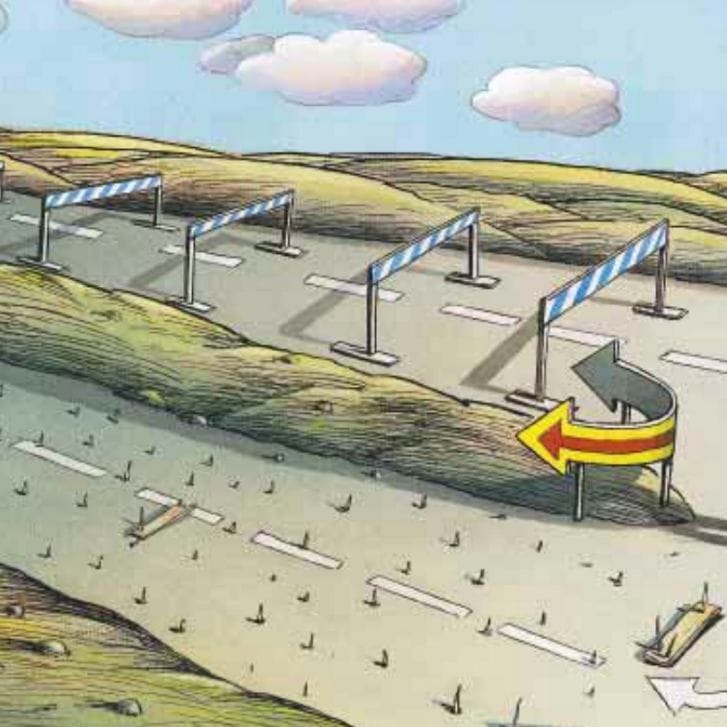Management Professor Daniel Raff vividly recalls discovering his passion for history. It was two weeks before his wedding, and he was still a graduate student trying to figure out what work needed doing by him. While poking around in the basement of the library on a Saturday morning, he ran into a former teacher who asked Raff whether he could help “beef up” a paper that was going to be published about Ford Motor Company’s early management decisions. Raff agreed to do some sleuthing in Detroit on the topic once he came back from his honeymoon. “The paper was intriguing, but the evidence – all from published sources – was thin. I figured if I crawled through enough attics, looking behind the cobwebs, I might be able to find some about the day-to-day operations of the firm that would shed decisive light on the speculations in the paper,” he says.
Within two-and-a-half days of getting to Detroit, he knew he had found his niche. “I found I just had a knack for identifying evidence among historical flotsam and jetsam of business that could shed light on systematic questions,” he recalls. “This sort of primary research on the operating problems and decisions of ordinary business life has helped me understand how firms, institutions within firms, and competitive conditions between firms have evolved over time.”
Today, Raff is known as Wharton’s resident business historian, holding a secondary appointment at Penn’s History Department and teaching Management 101, with a strong historical component, to Wharton undergraduates. While the history of the automotive industry is still a favorite topic of his, Raff, 50, also devotes much of his research time to a project studying the development of the distribution side of the economy over the long 20th century. He laughs, recalling how he stumbled into this area as a research topic. “It was two days before Christmas in 1986 when I entered the first book superstore in the suburbs of Washington, DC, in urgent need of a last-minute present for my distressingly well-read father. I realized in an instant that I hadn’t ever been in a store quite like this, one that could support such remarkably broad merchandising and still turn a profit,” he says. Raff recalls thinking that something about how the book business was run had quietly changed, and he decided to dig into the topic. “I’ve found that bookstores are the proverbial historian’s grain of sand in which you can see the world. I’ve been working on the details, in the small and in the large, ever since.”
For our Reunion retrospective, we’ve asked Raff for his observations on business trends since the 1940s. What factors have had the greatest impact on the economy and challenged Wharton graduates? What industries were hot? And how does the automotive industry – not to mention bookstores – fit into all of this? His answers follow.
What was the business environment like in the 1940s, and how did World War II affect the economy?
Understanding what happened in the 1940s requires recalling what happened immediately beforehand. The nation had never had a depression as severe as the one that reached its nadir in 1933; and we didn’t start to pull out of it until the last couple years of the decade. Images of out-of-work executives selling apples on the street and the lines of the unemployed outside soup kitchens are familiar. The position of Midwest farmers was desperate. Industrial capacity utilization had essentially collapsed. It was in the context of an economy with such radically underused resources that an activist role of the federal government really began to emerge. Roosevelt experimented with counter-cyclical fiscal policy (though not very aggressive by modern standards), and the federal government began to intervene actively in conditions at the industry level as well. Then, of course, the world descended into war. Those responsible for running the American economy needed to worry about using the productive capacity of the economy not just to provide consumers with things that they wanted, but to produce badly needed war materiel like jeeps, navy boats, airplanes, ammunition. The war mobilization was a very big deal. This involved a lot of manufacturing for the government on a cost-plus basis, as well as the government taking an interest in how shop-floor labor relations worked, because strikes in military supply industries during times of war would have a very corrosive effect on general civilian support for war.
By the end of WWII, our manufacturing sector was in radically better shape than those in all of the other industrialized nations. It was also true that an active regulatory role of government in the economy had become widely accepted. So by the end of the 1940s, we had massive productive capacity as well as room for big government.
If massive productive capacity and big government shaped business in the 1940s, what shaped it in the 1950s?
Towering over the 1950s you find the post-WWII – Cold War – suspicions of the Russians and their allies as well as concerns about revolution in China and, in response, a very substantial defense budget. You also saw development within American capitalism. Managerial corporations were becoming widespread and very large. Being a successful businessman increasingly meant having a corporate job.
The most striking development of the 1950s was the early growth of diversified conglomerate corporations. International Telephone and Telegraph (ITT), a prime example, had hundreds of subsidiary firms. The divisions were in many different lines of business that the corporate office really had to run them by the numbers – executive committees couldn’t really have expertise on such a wide variety of areas. So the conglomerate companies had to play at being capital markets. Yet they didn’t have great difficulty raising external finance, and they weren’t penalized for their diversification. It’s an interesting puzzle why this was so.
The simplest explanation for this lies in the idea that what conglomerates often brought to companies they purchased was systematic thinking about resource allocation, marketing, and finance. There still were not many people in business who had had any kind of systematic business education. Wharton had been granting undergraduate business degrees for three-quarters of a century, but we were the first, and even in the 50s there were not many such institutions. Nor were MBA programs as common as they are now. So the type of training which Wharton and a few other schools were providing was scarce and quite valuable. The conglomerates exploited it intensively.
What trends shaped business in the 1960s?
The 1960s were an expansionary time in the economy. This was the period where President Lyndon Johnson was explaining that we could have both guns and butter – the Vietnam War and the War on Poverty. It was also a period in which relatively undiversified American manufacturing firms were doing very well. You can look at the automobile industry, in which we were by far the world’s leader in that period, to get a sense of that spirit that all was possible. You could see it in the cars. This was even reflected in the pop music of the day – think of the Beach Boys singing “She’s real fine, my 409” – the engines, by present-day standards, were mammoth and immensely powerful. Think of ordinary production cars with trunks large enough for school kids to lie down in them. There was casual plenty.
When did this era of expansiveness end?
The situation changed quite radically in 1972 with the rise of OPEC and oil prices. The industrialized world sank into to stagnation and inflation. The general response of big business to this was not good. It was a blow, and they didn’t know how to respond to it. By the end of the decade, you could see two responses working their way through the system. One was that large American companies, who didn’t see that circumstances had changed for their customers, were not adapting their product offerings, quality, and service to meet those needs. So consumers became more open to buying alternate goods that were more attractive. For example, in the flagship auto industry, it turned out that the Japanese were rather good at making cars that didn’t use so much expensive gasoline and that had higher product quality. (They had to be good at these to survive, such were the conditions in their home market.) The Japanese firms were also much better at changing what they made to respond to the demands of consumers. Differences in practice and performance by the late 1970s were quite striking.
The other thing that emerged was that the capital markets roused from their critical slumber. They began to see clearly that many large businesses – many of these diversified conglomerates – were not using investors’ money very productively. And you began to see in the late 1970s the beginnings of a market in corporate control. That is, the old Wall Street rule of be happy or sell the shares went out the window; and active investors began trying to affect the firms’ policies or even to take over ownership and change the policies directly.
What phenomena defined business in the 1980s?
The most conspicuous phenomenon was that firms which had previously not been thought large or solid enough to issue securities began to be able to float their debt. This was the so-called junk bond market. This phenomenon converged with the previous one: the junk bonds were often issued in connection with attempts to change the ownership, management, and direction of firms which investors felt were not being properly run. As with most innovations, this development may well have run its course and kept on running. But there was an extended period during which investors in effect issued debt, bought up companies, made changes, and obtained superior corporate performance.
Another phenomenon going on in the 1980s, albeit more quietly, was the growing appearance of personal computers and sophisticated telecommunications equipment in workplaces and offices. The economist Robert Solow remarked to a New York Times reporter late in the decade that you could see computers everywhere but in the productivity statistics. This was probably true because there was a much more widespread sense that computers would someday be important in a rationalization of business practice than there was any concrete idea on how to use computers to bring it about.
So the theme of the 1990s was learning how to use technology?
Indeed. There began to be concrete ideas and much more of a focus on supply chain organization and coordination. Productivity-enhancing software that allowed computers to work productively in networks began to emerge, and firms began to learn how to gather information and exploit it. The jury is not yet in as to whether the recent productivity growth is owed to information technology or not. You can’t solidly argue this from the government statistics yet, but McKinsey has recently published a study arguing, partly on the basis of statistics and partly on the basis of industry case studies, that this is precisely what happened in the second half of 1990s. This productivity growth was powered to some extent by the increasing dominance of some extremely proficient retailing firms like Walmart (which is now by total revenue the largest company in the economy). It had really gotten the message about how to use information technology in retailing practice and was requiring, through a series of vertical partnerships with its suppliers, that they basically get with the program.
The other conspicuous development was that of the Internet and the related NASDAQ stock bubble. For a while, this made Northern California the center of the economic universe. There isn’t much doubt that the underlying ideas and inventions of many of these companies didn’t really come to much; and the shares of many are now not worth very much. But the fundamental innovations of IT and the Internet are going to have very profound and long-lasting effects on business conduct and the way ordinary consumers live their lives.
I find few more dramatic examples of this than in a line of business that seems very firmly old economy – bookstores. If you go back as recently as the early 1970s, the only places in the United States where you could find any substantial bookstores were in central business districts of major cities and in big university towns. Aside from that, if you wanted to buy a book, you mostly went to a very small store on the main street of your town or to a two- or at most four-thousand-square-foot box store in the mall. Neither had very elaborate merchandising at all. This has changed utterly beyond recognition now – even without Amazon.com. There are well over 1,000 bookstores in the United States, mostly in suburban locations in 30,000-square-foot facilities, many stocking in excess of 100,000 titles. These operations would be impossible without modern information technology. The information technology infrastructure is what makes it possible to have broad assortments of inventory without terrible dangers of getting stuck with huge amounts of stock that no one wants to buy. It may be that the big IT-related development in business isn’t Amazon getting bigger, but rather that, in addition to whatever undoubtedly substantial Internet commerce does eventually emerge, bricks-and-mortar retailing now provides better selection and easier access to customers’ most preferred choices than it did in past, possibly with better cost structures and prices as well.
What has the job market been like for Wharton graduates over the years?
In the 50s and 60s, the business world was pretty expansive, as I say; and particularly since the training we provided was scarce and valued, the job markets were good. The 70s were a relatively difficult time because of stagflation. But the 80s were good, not least because one of our historic strengths is finance, and Wharton has long been a prime supplier of executive labor to the financial institutions world. In the 90s, many of our graduates became involved with start-ups. It is harder to know how things will play out in the immediate future; it is certainly true that our alumni base is growing, and it is clear that they are more self-identified as alumni of Wharton, and their value to one another as a network is on the rise.
What business trends will today’s graduates face in the near future?
I would be very surprised if we went back into days as heavily expansive as the 1990s bubble time, but there seems to be not much doubt that the economy is improving again now. My hunch is that sectors related to making consumer/producer goods will continue to do fairly well. And sectors that rely on systematic management education and technical skills will continue to do very well because the underlying economy is in midst of sea change that will demand both. The financial services industries are also in the midst of serious transition, and it’s not just the consolidation. It is becoming increasingly true that financial services aren’t as geographically constrained as they once were. There are areas of the world which have been radically underserved by financial services and which are becoming open to expansion, such as South Asia and China in particular. Our graduates have the skills to help.
Globalization seems to be playing a more significant role in management education…
It’s different from the last time globalization was a big theme, in the 1960s and early 1970s. Then, the focus in business schools was on the novel difficulties of running corporations which had to do business in many places and with different cultures. The demands on organization were complex, and both structures and systems methods needed to be worked out. The emphasis now is not so much on working out the corporate infrastructure required to respond to these demands as it is on the massiveness of opportunities and the difficulties of actual execution.
Programs such as the Huntsman Program in International Studies and Business for undergrads and the Joseph H. Lauder Institute of Management and International Studies for MBAs provide training which will enable our students to step ably into highly multinational firms and responsibilities. These programs were ahead of their time and stand as examples to us as the sort of resources we need to invest to produce management education really well suited to the times into which we are moving.
Meghan Laska is an associate director for Wharton’s communications department.


























